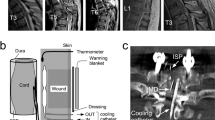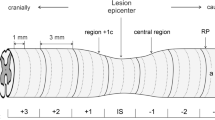Summary
¶ Systemic hypothermia exerts neuroprotective effects following trauma and ischemia caused by vascular occlusion in the brain. In the spinal cord similar effects have been demonstrated following ischemia after aortic occlusion. We have previously presented protective effects on several morphological parameters in the early period after the injury, using an established spinal cord compression injury model and systemic hypothermia. In the present study we have evaluated the effects on motor function following severe spinal cord compression trauma and treatment with moderate systemic hypothermia.
Thirty Sprague Dawley rats were randomized into three groups: In group 1 (n=4), the animals underwent a hypothermic procedure, including a 2 h hypothermic period with a body temperature of 30°C, following the initial laminectomy. In group 2 (n=12) a 50 g compression was applied to the spinal cords for 5 min, after which the animals were kept under normothermic anesthesia for 3 h. In group 3 (n=14), the animals underwent the same trauma procedure as in group 2 and the same hypothermic procedure as in group 1. The animals were allowed to survive for 14 days, during which the motor function was recorded.
This degree of trauma results in a non-reversible paraplegia, and the addition of systemic hypothermia as described above did not alter the neurological recovery as measured by two different methods of recording the motor function up to two weeks after injury. All animals survived in group 1. However, the mortality rates in group 2 were 25% and in group 3, 50%, respectively, which mirrors the severity of the trauma.
The application of systemic hypothermia and the lack of experimental therapeutic success highlight the difficulties of transferring experimental beneficial neuroprotective effects to a clinically useful treatment method. In this experimental set-up the effects of the severe primary injury may overshadow the effects of the secondary injury mechanisms, which limits the therapeutic possibilities of systemic hypothermic treatment.
Similar content being viewed by others
Author information
Authors and Affiliations
Rights and permissions
About this article
Cite this article
Westergren, H., Farooque, M., Olsson, Y. et al. Motor Function Changes in the Rat Following Severe Spinal Cord Injury . Acta Neurochir (Wien) 142, 567–573 (2000). https://doi.org/10.1007/s007010050471
Issue Date:
DOI: https://doi.org/10.1007/s007010050471




